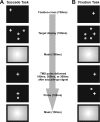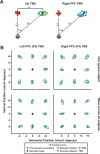Transcranial magnetic stimulation over posterior parietal cortex disrupts transsaccadic memory of multiple objects
- PMID: 18596168
- PMCID: PMC6670980
- DOI: 10.1523/JNEUROSCI.0542-08.2008
Transcranial magnetic stimulation over posterior parietal cortex disrupts transsaccadic memory of multiple objects
Abstract
The posterior parietal cortex (PPC) plays a role in spatial updating of goals for eye and arm movements across saccades, but less is known about its role in updating perceptual memory. We reported previously that transsaccadic memory has a capacity for storing the orientations of three to four Gabor patches either within a single fixation (fixation task) or between separate fixations (saccade task). Here, we tested the role of the PPC in transsaccadic memory in eight subjects by simultaneously applying single-pulse transcranial magnetic stimulation (TMS) over the right and left PPC, over several control sites, and comparing these to behavioral controls with no TMS. In TMS trials, we randomly delivered pulses at one of three different time intervals around the time of the saccade, or at an equivalent time in the fixation task. Controls confirmed that subjects could normally retain at least three visual features. TMS over the left PPC and a control site had no significant effect on this performance. However, TMS over the right PPC disrupted memory performance in both tasks. This TMS-induced effect was most disruptive in the saccade task, in particular when stimulation coincided more closely with saccade timing. Here, the capacity to compare presaccadic and postsaccadic features was reduced to one object, as expected if the spatial aspect of memory was disrupted. This finding suggests that right PPC plays a role in the spatial processing involved in transsaccadic memory of visual features. We propose that this process uses saccade-related feedback signals similar to those observed in spatial updating.
Figures








Similar articles
-
TMS over human frontal eye fields disrupts trans-saccadic memory of multiple objects.Cereb Cortex. 2010 Apr;20(4):759-72. doi: 10.1093/cercor/bhp148. Epub 2009 Jul 29. Cereb Cortex. 2010. PMID: 19641017
-
The effects of TMS over dorsolateral prefrontal cortex on trans-saccadic memory of multiple objects.Neuropsychologia. 2014 Oct;63:185-93. doi: 10.1016/j.neuropsychologia.2014.08.025. Epub 2014 Sep 1. Neuropsychologia. 2014. PMID: 25192630
-
Effects of single-pulse transcranial magnetic stimulation over the prefrontal and posterior parietal cortices during memory-guided saccades in humans.J Neurophysiol. 1996 Sep;76(3):2102-6. doi: 10.1152/jn.1996.76.3.2102. J Neurophysiol. 1996. PMID: 8890321 Clinical Trial.
-
Specialization of reach function in human posterior parietal cortex.Exp Brain Res. 2012 Aug;221(1):1-18. doi: 10.1007/s00221-012-3158-9. Epub 2012 Jul 10. Exp Brain Res. 2012. PMID: 22777102 Review.
-
Cortical mechanisms for trans-saccadic memory and integration of multiple object features.Philos Trans R Soc Lond B Biol Sci. 2011 Feb 27;366(1564):540-53. doi: 10.1098/rstb.2010.0184. Philos Trans R Soc Lond B Biol Sci. 2011. PMID: 21242142 Free PMC article. Review.
Cited by
-
rTMS over the human medial parietal cortex impairs online reaching corrections.Brain Struct Funct. 2024 Mar;229(2):297-310. doi: 10.1007/s00429-023-02735-7. Epub 2023 Dec 23. Brain Struct Funct. 2024. PMID: 38141108 Free PMC article.
-
Hand placement near the visual stimulus improves orientation selectivity in V2 neurons.J Neurophysiol. 2015 Apr 1;113(7):2859-70. doi: 10.1152/jn.00919.2013. Epub 2015 Feb 25. J Neurophysiol. 2015. PMID: 25717165 Free PMC article.
-
Predictability of saccadic behaviors is modified by transcranial magnetic stimulation over human posterior parietal cortex.Hum Brain Mapp. 2011 Nov;32(11):1961-72. doi: 10.1002/hbm.21162. Epub 2011 Jan 21. Hum Brain Mapp. 2011. PMID: 21259383 Free PMC article.
-
Saccades influence functional modularity in the human cortical vision network.Sci Rep. 2025 Mar 28;15(1):10683. doi: 10.1038/s41598-025-95568-9. Sci Rep. 2025. PMID: 40155663 Free PMC article.
-
The Role of the Precuneus in Human Spatial Updating in a Real Environment Setting-A cTBS Study.Life (Basel). 2022 Aug 15;12(8):1239. doi: 10.3390/life12081239. Life (Basel). 2022. PMID: 36013418 Free PMC article.
References
-
- Andersen RA, Essick GK, Siegel RM. Encoding of spatial location by posterior parietal neurons. Science. 1985;230:456–458. - PubMed
-
- Beck DM, Muggleton N, Walsh V, Lavie N. Right parietal cortex plays a critical role in change blindness. Cereb Cortex. 2006;16:712–717. - PubMed
-
- Beckers G, Zeki S. The consequences of inactivating areas V1 and V5 on visual motion perception. Brain. 1995;118:49–60. - PubMed
Publication types
MeSH terms
LinkOut - more resources
Full Text Sources
Other Literature Sources
Medical
